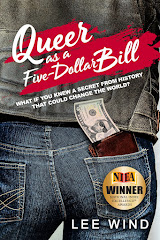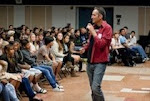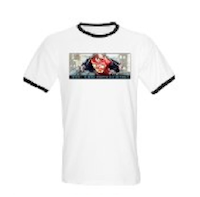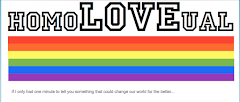AGENTS AND EDITORS
NEED TO ADVERTISE THEIR INTEREST IN DIVERSITY
That's the idea. And this series is an effort to do just that.
For now, we're focusing on agents, and today's post features agent Sara Megibow of
KT Literary.
 |
| Agent Sara Megibow (photo by Kate Testerman) |
Here's Sara's bio:
Sara Megibow is a literary agent with almost 10 years experience in publishing. She represents novels in these genres: middle grade, young adult, romance, science fiction and fantasy. Her authors include New York Times bestsellers Roni Loren and Jason Hough and USA Today and international bestsellers Ashlyn Macnamara, Juliana Stone, Stefan Bachmann and Tiffany Reisz. Please follow her on twitter @SaraMegibow where she will try her best to answer further questions.
And here's our interview:
Lee: Hi Sara!
Sara: Hi Lee!
Lee: Thanks so much for agreeing to talk about your interest in Diversity in Children's and Teen Literature!
Sara: My pleasure - thank you for posting these wonderful interviews and for promoting diversity in Children’s and Teen Literature! This is a very important topic! And thanks for having me here today!
Lee: There's been growing discussion about how the 5,000 or so traditionally published books a year don't reflect the actual diversity of our world, including the #WeNeedDiverseBooks movement and the stunningly low numbers of representation revealed in "
Children's Books by and about People of Color Published in the United States," put out by the CCBC (The Cooperative Children's Book Center.)
To start us off, of the submissions you get, let's say in the past year, how many of those projects included some kind of diversity of characters or theme?
Sara: I represent middle grade, young adult, romance, science fiction and fantasy but since this blog post is addressing children’s books specifically I will limit my answers to those submissions.
In 2015 I will read roughly 15,000 query letters for middle grade and young adult novels. Of those submissions the vast majority of writers don’t disclose their race, religion, sexual orientation, age, background or gender. So, I can’t solidly answer this question in regards to the authors themselves.
However, roughly one third of these 15,000 submissions will clearly identify the book's characters or themes as those with some kind of diversity.
Lee: Let's unpack that a bit: Are you seeing many stories featuring protagonists of color?
Sara: Great question! I feel like there aren’t enough protagonists of color in my slush pile yet. I’m always on the lookout but only 10% of the queries I read clearly mention protagonists of color.
Two of my favorite reads of 2015 have been BROWN GIRL DREAMING by Jacqueline Woodson and LISTEN, SLOWLY by Thanhhà Lai - these are the kinds of books I’m looking for and these two titles (two of many!) are great examples of superior storytelling featuring protagonists of color. Buy them, read them and spread the word.
Lee: I loved Brown Girl Dreaming! And I just added Listen, Slowly to my holds list at my local library. Thanks for the recommendation!
How about LGBTQ characters, and please break that down - are you seeing lesbian characters? gay? bi? trans*? questioning? queer or gender non-conforming?
Sara: 15-20% of the middle grade and young adult queries I read feature gay, lesbian, bi and transgender protagonists both in fantasy stories (like ASH by Malinda Lo) and in contemporary stories (like OPENLY STRAIGHT by Bill Konigsberg). This 15-20% represents slightly more stories about gay young men and slightly fewer stories about transgender or bi characters. Also, this breakdown skews more heavily toward the young adult novels than the middle grade novels.
Lee: How about characters with disabilities?
Sara: BREAKING BEAUTIFUL by Jennifer Shaw Wolf is a contemporary young adult novel from 2012 starring twins - one of whom has cerebral palsy and is in a wheelchair. This book ended up on tons of state reading lists, won several awards and is a great example of a successful book starring characters with disabilities. Characters with disabilities show up in about 5-10% of the queries I see although many times these characters are the best friend or sibling. I would love to see more characters with disabilities who are the lead protagonist.
A great success story for lead protagonists with disabilities is the upcoming THE WEIGHT OF ZERO by Karen Fortunati (Fall 2016, Delacorte/ Penguin Random House). THE WEIGHT OF ZERO is the story of a teenager with bipolar disorder who is contemplating suicide, and her march towards - and struggle to recognize - better mental health, supported by a network of family, doctors and friends. This is the book librarians and teachers have been begging for - a story that shows the potential when effective treatment and support networks work together. Karen is a debut author and this sale made a huge splash when it sold to Delacorte on an exclusive submission just a few months ago.
Lee: Are you seeing other types of diversity in the works submitted? - And please share any specific categories that spring to mind.
Sara: I’d love to see more religiously-observant protagonists. Our family is made up of observant Jews and I feel it’s rare to see a hero who wears a yarmulke or a heroine whose family keeps kosher. And I think I’d fall flat out of my chair if I read a protagonist who studied Talmud or had friends over for a Sukkot dinner.
I’d love to see more observant Muslims, Hindus, Buddhists, Jews, Catholics - you name it, I think we need more representation of religious diversity.
I’d also like to see more protagonists from different socio-economic backgrounds. Miranda Kenneally’s contemporary young adult novels show wonderful socio-economic diversity. Her novel RACING SAVANNAH is a great example of an upstairs/downstairs theme set on a horse farm and CATCHING JORDAN accurately portrays the broad range of wealth at a public school in Tennessee.
In general, when a query letter clearly identifies its characters that letter most often talks about race, gender or sexual orientation. All forms of diversity are important! We need religious diversity, socio-economic diversity, protagonists with a disability, protagonists from diverse cultures. We need all these voices to accurately represent our colorful, wonderful world! That may sound like a bumper sticker but it’s true.
Lee: Yes! I completely agree!
How about the creators? Are you seeing under-represented writers and illustrators submitting to you?
Sara: Lee, this is another great question and one that’s very tough to answer.
Rarely does a writer identify herself in a query letter. Also, identifying oneself won’t increase or decrease that person’s chances of receiving an offer of representation from me. I read all queries equally and am looking for superior writing combined with a unique story. I actively pitch diverse books but I don’t necessarily identify the writer when I pitch their book to a publishing house. For me, a person’s background, gender, sexual orientation, culture, socio-economic status, ability, race, religion, age, country of origin, etc. won’t make or break whether I will be their agent.
I am seeing under-represented writers submitting to me and I am offering representation to under-represented writers. As always, I am looking for more more more! More authors from diverse backgrounds! More stories starring diverse protagonists! My door is never closed to any author and no rejection letter has ever been sent (by me) to an author because of who they are or who the characters in their stories are.
A side note - I feel it’s naive to assume that Quality Is Everything is the only answer here. Under-represented authors haven’t had the attention they deserve for their books or for themselves. I wish I had a more complete and effective answer besides just “Quality! Quality!” Also, I acknowledge that we see bad books on the shelves by mainstream authors and amazing books that never get published by under-represented authors. I acknowledge the hypocrisy in the system and I’m working on it. Tweet me if you have questions or comments!
Lee: There's a lot of discussion about who has the 'right' to tell the story of an under-represented type of character. What's your take?
Sara: I want more diverse books to recommend AND I want more books written by diverse authors. Both are important.
I’d love to see more observant Jews in children’s books but I don’t necessarily need those books to be written by observant Jews. I’m bisexual and I’d love to see more bisexual heroines in middle grade and young adult books - especially starring in stories that aren’t necessarily coming-out stories. But again, I don’t necessarily need those books to be written by bisexual women.
But to the point above about under representation I ALSO want to see authors of diverse backgrounds. So I guess my take on it is…both! I want to see more diverse books written by anyone and more diverse books written by authors of diverse backgrounds!
Lee: When you're submitting projects to editors, do you think stories with under-represented characters take more 'selling' on your part?
Sara: Personally? No - in my experience under-represented characters don’t take more “selling”. I have an excellent reputation at publishing houses and editors know I only shop quality material. If I shop a book with an under-represented character it will be taken seriously.
Lee: I often feel the sense of ‘otherness’ is transferable. That from my own experiences being marginalized (for being Gay, being ill as a teen, being Jewish, being an Atheist, etc…) I feel tremendous empathy for people who are marginalized for other kinds of ‘otherness’ as well.
Can you share what’s driving your desire to see more diversity in Children’s and Teen books?
Sara: In 2010, Matisyahu was interviewed on David Letterman and asked, “what can’t you do as a musician because of your religious observance?” and I felt so let down by that question. I remember wondering, "when is someone going to ask what does religious observance BRING to your life? or what CAN you do because of your religious observance?”
Also in 2010 I heard Mitali Perkins (author of BAMBOO PEOPLE and others) speak beautifully on mirror books and door books. She described mirror books as ones in which kids see themselves in a book and door books as ones in which kids are introduced to a world new to them. That was an a-HA moment for me. My curriculum as a child-reader was made up entirely of door books - specifically door books with an agenda. At Ms. Perkins's presentation I realized that part of my goal as an agent in children's publishing was to work on door books that were more authentic (not agenda-driven) and mirror books in which kids could relate to the protagonists. In addition, I identified that my own personal agenda had been influenced by that Matisyahi interview. I wanted to help authors bring books to the market that answer the question, “what does my diverse background bring to my life and my books?”
Those two moments were the one-two punch for me and I’ve been actively searching for diverse books ever since.
Lee: I love knowing that. And I like Mitali's mirror/door metaphor a lot. I've been using mirror/window, but 'door' is much more accurate - it's not just looking at that world, books are inviting us into those worlds different than our own. I think I'll change how I speak about mirror books and door books from now on...
Can you tell us about other books that highlighted or included diversity that you loved and that inspired you (maybe even ones you wish you represented). What’s a Picture Book favorite?
Sara: My niece and nephews are African American and our local indie bookstores have been wonderful resources for helping me buy picture books with heroines and heroes of color. Our favorite picture book is I GOT THE RHYTHM by Connie Schofield-Morrison, illustrated by Frank Morrison (this book is an absolutely perfect match for my niece - talk about a mirror book! YES YES!)
Another family favorite is FIREBIRD written by Misty Copeland and illustrated by Christopher Myers.
Lee: Middle Grade?
Sara: For me, WONDER by R.J. Palacio was the most important and memorable read of a decade. I laughed, I cried and then I bought 13 copies of the book for my son’s classrooms, libraries and teachers. We successfully had WONDER added to the reading lists for all elementary classes at his school. Such a powerful and amazing book. Just…WOW.
Lee: Young Adult?
Sara: FAR FROM YOU by Tess Sharpe stars one of the best bisexual heroines I’ve ever read - she reminded me so much of me as a teen. I couldn’t put this book down and I recommend it constantly.
Lee: Okay, here’s your wish list moment. What are you looking for? Put out the call…
Sara: I am looking for absolutely anything as long as the book is:
1) 100% complete
2) expertly crafted
3) never previously published
4) middle grade (any sub-genre), young adult (any sub-genre), romance (any sub-genre), science fiction or fantasy (for the MG, YA or adult market)
I don’t offer representation by concept but rather based on quality of writing. So, if someone asks, “I wrote a book about giraffes in space, are you interested?” my response will always be, “it depends on the quality of writing.” I’m looking for superior craft plus a unique story. The door is always always always open for diverse protagonists and diverse authors. I care passionately about these things and it’s always beneficial to mention diversity in a query. Then, to get past the query stage, make sure the manuscript demonstrates a superior mastery of craft.
Lee: And for writers and/or illustrators reading this who feel a resonance with what you’ve shared and who want to submit to you, how should they go about that?
Sara: Thanks! The first step is to make sure that manuscript is 110% complete, fully edited and really, really, really ready to go.
Then, I recommend reading a few books in your genre to make sure you have a high-level grasp of the market. Are you preparing to submit a contemporary middle grade novel? Then read 2-3 contemporary middle grade novels published recently by major publishing houses.
Write, edit, read. Then…
Prepare a one page query letter and email it to me along with the first 3 pages of the manuscript right there in the body of the email. Please include, “I saw your interview with Lee about diversity” in the first sentence of the query letter.
My query email address is saraquery (at) ktliterary (dot) com
The KT Literary website is:
www.ktliterary.com
The submission guidelines for KT Literary are listed in full here:
http://ktliterary.com/submissions/
Lots and lots and lots of help for writing that query letter is posted here:
http://ktliterary.com/category/ask-daphne/about-my-query/
My client info, books, conference schedule and sales info is updated here:
http://www.publishersmarketplace.com/members/SaraMegibow/
I am on twitter @SaraMegibow
Lee: Anything I didn’t ask that you’d like to add?
Sara: Yes, thanks Lee. One more thing to add.
A mantra: FIND + BUY + READ + TALK ABOUT
Let me break it down…
There are four steps to commercial success in publishing. First, a reader must FIND a diverse book (discoverability), then that reader must BUY the diverse book (conversion), then the reader must READ the diverse book (consumption) and then the reader must TALK ABOUT that diverse book (word of mouth). Yes we need more diverse books and more diverse authors! While Lee and I (and all the other amazing agents and editors on Lee’s blog) are on that hunt, please please please please help promote the wonderful diverse books that are already out there!
Want more books with queer protagonists? Buy, read and talk about the ones already out there! Want more books with protagonists of color? Same thing = buy, read, talk about! Want more protagonists with disabilities? Buy, read and talk about the books that are on shelves right now.
We Need Diverse Books hosts a wonderful website with oodles of resources for finding diverse books. Booksellers and librarians are excellent resources (or should be - if they are not, direct them politely to the We Need Diverse Books website). Want more diverse books in the libraries of your kids' schools? Buy them or run a fundraiser to earn the money to buy them.
There are gatekeepers in publishing but at the end of the day the biggest gatekeeper is the consumer. Vote with your dollars!! Reminder = YES! Authors make money when you borrow books from the library! Asking for a book at the library is furthering our agenda as much as buying from a bookstore.
FIND + BUY + READ + TALK ABOUT
Lee: Great advice! Getting the world of Children’s literature to better reflect the diversity of our world -- the world kids today are growing up in -- is so important. Thank you so much for working to make things better!
Sara: And thank you Lee for all your hard work and for bringing more conversation to the topic of diversity in children’s literature!
Thanks again, Sara! Look for another AGENT LOOKING FOR DIVERSITY interview on the first Monday of next month. Until then,
Illustrate and Write On!
Lee
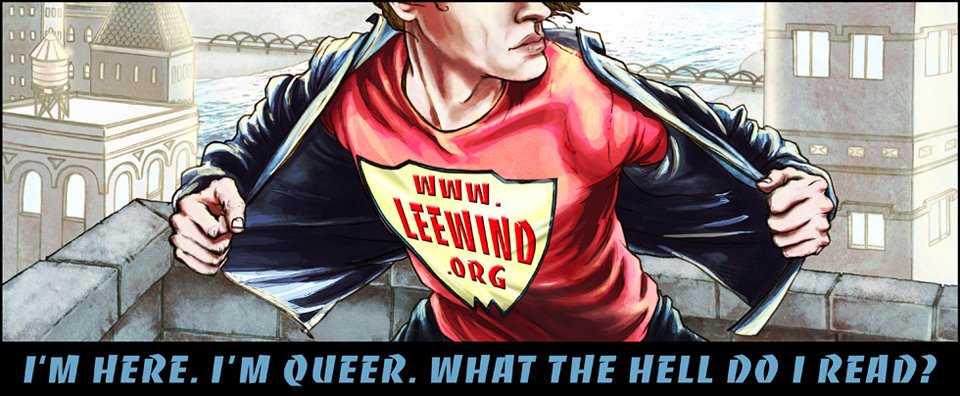960.jpg)




















